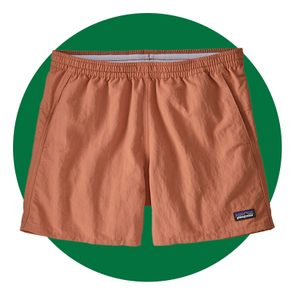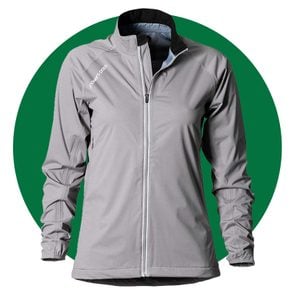8 Best Hiking Pants for Men
Updated: Sep. 23, 2021
You should put some thought into the hiking pants you wear. Here's how to make sure you have the right hiking pants before you hit the trail, plus a few popular examples.
Our editors and experts handpick every product we feature. We may earn a commission from your purchases.
Put your hiking pants on
Not many people forget to take pants on a hiking trip, but many hikers do take their pants for granted, failing to give them enough thought until it’s too late.
It’s easy to under-think your pants when planning a hiking trip, perhaps partly because we wear pants every day anyway. It can be tempting to just bring a familiar pair of jeans or khakis, especially if you’re already spending money on other hiking gear essentials like shoes, socks, a backpack, or water containers.
That’s often fine for shorter, simpler hikes in temperate weather, but like other types of outdoor gear, any problems with your pants may grow exponentially as the distance or difficulty of the hike increases.
That’s why we asked experts about the best types of hiking pants for men. They share what to look for when buying hiking pants and offer some suggestions, too.
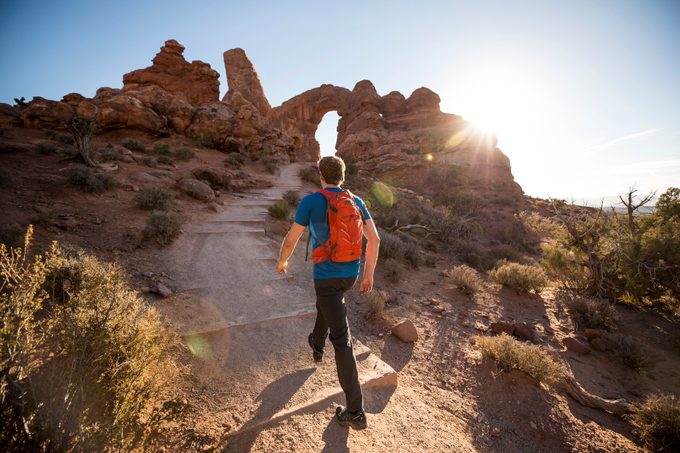
What to look for in hiking pants for men
The best hiking pants for men depend largely on the hike and the hiker. Consider the climate and season of the hike, along with the weather forecast and recent history, to anticipate issues like mud or flooding from recent rainfall.
Factor in your own preferences and comfort, too, but remember some pants might feel less comfortable after days on the trail than they do for shorter periods in daily life. If you’re backpacking, it’s often wise to bring an extra pair of pants, shorts, or both.
Here are a few important factors to consider when choosing pants for hiking:
Material
As with hiking socks, cotton isn’t the best material for hiking pants.
“We typically recommend that people avoid using cotton pants, because cotton holds moisture, and doesn’t hold its insulate properties when it becomes wet,” says Wesley Trimble, communications and creative director for the American Hiking Society (AHS). Cotton can be OK for many day hikes, or even some backpacking trips in dry, mild weather, but it’s generally better to steer clear of cotton if possible.
That includes many khaki pants as well as jeans, since denim is made from cotton.
“I would avoid things like jeans, because you can get really hot and sweaty, and if it rains, they get super heavy and never dry,” says Kate Van Waes, executive director of the AHS.
Instead of cotton, many hikers opt for pants made with a blend of synthetic materials, particularly nylon with polyester and/or elastane.
“We recommend people look at synthetic materials,” Trimble says. “Something that’s going to dry quickly and wick moisture, both sweat, and water, whether it’s from creek crossings or from rain or whatever.” Climate, season, and weather forecast are all important factors to consider—light and breathable pants are great in many conditions, for example, but thicker, more water-resistant pants might work better for some winter hikes.
Fit
A slimmer fit can mean less fabric and less weight, but you also don’t want to be fighting tight pants throughout your hike. That’s another advantage of synthetic materials—nylon and polyester are lightweight and quick to dry, and elastane (spandex) can add valuable stretchiness.
Some hiking pants also have articulated knees, or special fabric sections sewn in at the knees with “darts” (triangle-shaped folds). These provide better mobility, similar to the gusset in the crotch of some pants.
These may not be necessary, but if you’ve noticed your pants feeling tight in the knees or crotch on previous hikes, such as when taking a big step up, they could be worth looking into.
Convertibility
Pants that seemed suitable at the trailhead sometimes turn out to be surprisingly inadequate once you’re miles into your hike. That could be due to changing weather conditions, or it might be because you’re changing elevations as you hike.
In any case, it’s often smart to bring shorts and long pants, especially for backpacking trips in spring, summer, or fall. Shorts can be great for hiking in heat, although they can leave your legs exposed to thorns, nettles, poison ivy, and sunlight, so it’s nice to have long pants, too, even if you don’t expect cold weather.
One convenient way to do that is by wearing adjustable-length pants, potentially saving space and weight in your pack as well as making it easier to switch between long and short pants.
There are two basic types of pants in this category: zip-off/convertible pants and roll-up pants. The former has a zipper at the knee, letting you zip off the lower legs to create shorts, and the latter features snaps or buttons to hold the rolled cuffs in place.
Many hikers like the flexibility of zip-off pants, although the knee zippers add weight, are sometimes difficult to operate, and leave you with two unmoored, easy-to-lose pant legs.
Roll-up pants avoid some of those issues, but some people still find the rolled pant leg uncomfortable. Either type can be helpful on the trail; it’s mainly a matter of personal preference.
Pockets
Many hiking pants for men have pockets, but while that can be useful in some situations, it can also be a nuisance on the trail.
Even when empty, each extra pocket adds a little more weight—especially if the pockets have zippers, buttons, or snaps—and some pockets near the waist are rendered impractical by your backpack’s hip belt (which might have its own pockets, anyway).
Hiking with objects in your pant pockets can be uncomfortable, too, so it’s often best to use your backpack for storage as much as possible.
Still, it can be nice to have simple side pockets on the upper legs of your pants, for stashing items you’ll want to reach frequently without taking off your backpack, like a cellphone, map, or pocketknife.
Extra pockets can also help on day hikes, when you might want the extra storage because you’re carrying a smaller backpack. And if you’re hiking with kids, Van Waes points out, more pockets are often better because “you’re going to be carrying a lot of rocks back to your car.”
Cost
Not everyone needs to buy fancy hiking pants. In many cases, you might be fine buying inexpensive pants or wearing pants you already own, especially if they’re lightweight, quick-drying, and well-suited to the weather where you’ll be hiking.
“A hike is just another kind of workout,” Van Waes says. “You don’t have to have those zip-off-at-the-knees old-school hiking pants.”
That said, fancy hiking pants do offer significant benefits, and if you go hiking often enough, there will likely be times you’re glad you have them.
They may not be must-have hiking gear, but they can help you stay safe and comfortable in variable conditions, typically with less weight than other types of pants.
(These are the benefits of hiking.)
The best hiking pants for men
If you’re thinking about buying a pair of hiking pants for your next excursion, here are a few highly regarded options you might want to consider.
Columbia Silver Ridge
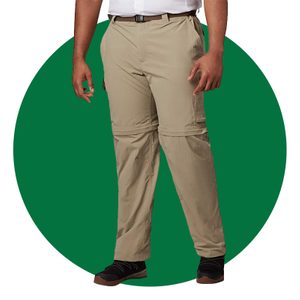
These popular convertible pants from Oregon’s Columbia Sportswear are lightweight, breathable, moisture-wicking workhorses with lots of useful pockets. At $60 or less, they’re also among the best values of any hiking pants for men.
Silver Ridge pants work well for casual day hikes as well as more intensive backpacking treks, especially in warm and dry conditions, thanks to their breathable 100% nylon fabric and lightweight (less than 12 ounces).
These convertible pants zip off into shorts, and they also feature UPF 50 sun protection. Their nylon fabric is reasonably tough, at least for $60, although it may not match the durability of some pricier hiking pants, and might be inadequate for hiking in wet or cold conditions.
Prana Stretch Zion
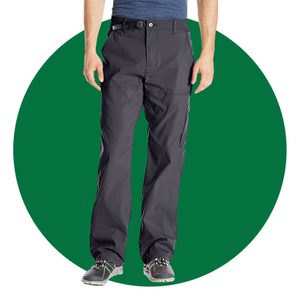
Acclaimed for their durability, versatility, and stretchiness, these roll-up pants from California-based Prana have a lot to offer for a little less than $100.
Their stretchy fabric (97 percent nylon, 3 percent spandex) is heralded for its effect on range of motion, boosting their popularity as pants for climbing as well as hiking. Stretch Zions have a durable water-repellent finish, offering more resilience and versatility for cold or wet weather.
They’re known for being a little stuffy in high temperatures, although they can roll up (with snaps) to help you cool off. They aren’t the lightest pants, weighing around 13 or 14 ounces depending on size, but their combination of qualities nonetheless makes them a good investment for many hikers.
Outdoor Research Ferrosi
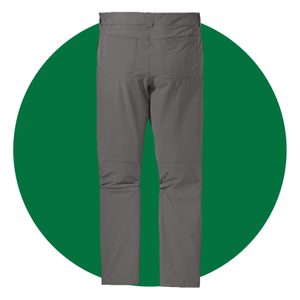
Made with 86 percent nylon and 14 percent spandex, these multi-season hiking pants from Outdoor Research offer high durability and stretchiness, but also breathability and low weight (10 to 12 ounces, depending on size).
Their tough, stretchy fabric is aided by a gusseted crotch and articulated knees, providing high mobility for hiking as well as many other outdoor endeavors.
They provide water resistance and UPF 50 sun protection, with a mix of durability, flexibility, and low weight that can serve well on long backpacking trips. They also cost about $80, less than many comparable hiking pants.
Patagonia Quandary
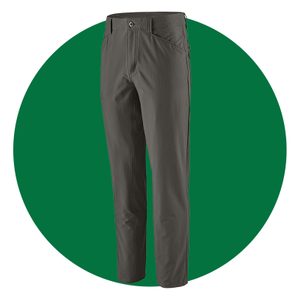
At about 10 or 11 ounces, depending on size, these stretchy, multifunctional pants from Patagonia boast an impressively low weight that can help with covering distance.
Like many comparable options, they come with water resistance and UPF 50 sun protection, but they also offer a fit and design that can help them pass as non-hiking pants more easily than some.
Quandary pants are made with 95 percent nylon—65 percent of which is recycled, according to Patagonia—and 5 percent spandex, with a gusseted crotch and articulated knees. Their low weight makes them well-suited to long distances and warm weather, and their $80 price is relatively affordable.
Arc’teryx Gamma LT
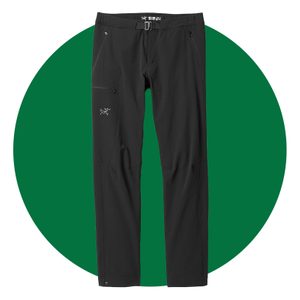
If you’re looking for a powerful pair of hiking pants, and you aren’t especially concerned about price, these $189 soft-shell pants from Arc’teryx might be of interest.
They are beyond the legwear budget for many hikers, but they are also durable and comfortable even in cold, wet weather. So they may be worth considering if you’re planning a backpacking trip in severe conditions.
Made with 88 percent nylon and 12 percent elastane, the Gamma LT feature mobility-enhancing features like a gusseted crotch and articulated knees, and can stand up well against wind and water.
Depending on size, they weigh about 11 to 13 ounces, which is relatively light for such heavy-duty pants, but that’s all moot if you can’t afford them.
ATG by Wrangler Trail Jogger
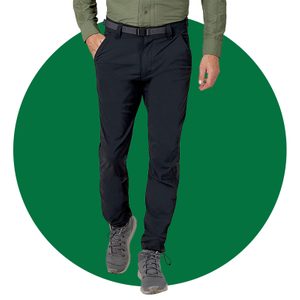
On the other end of the price range, these quick-drying, water-resistant hiking pants for men from Wrangler’s All-Terrain Gear brand could work for beginner or casual hikers looking for minimal investment.
They may not rival the performance of other pants in this list, but they aren’t super heavy (about 13 ounces, depending on size), and their 96 percent nylon, 4 percent spandex fabric features a water-repellent finish to fend off moisture.
They also feature UPF 30 sun protection, vented knees to help regulate temperature, and a drawcord at the lower pant leg to adjust the length and fit. Perhaps most importantly, they cost less than $30.
(Check out these hiking poles, too.)
Eddie Bauer Guide Pro
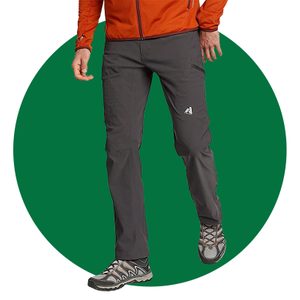
These lean-fitting, lightweight pants from Eddie Bauer are made with 94 percent nylon and 6 percent spandex, offering stretchy fabric and articulated knees for high mobility.
They are versatile for a wide range of conditions, with high durability, water resistance, and UPF 50 sun protection. They also provide a versatile style, working relatively well on or off the trail.
They’re generally under $70 and weigh about 12 ounces, depending on size. Still, they may fall short of some other hiking pants that only cost a little more.
TBMPOY Hiking Pants
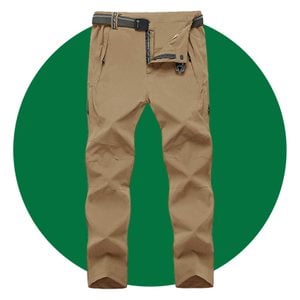
Comparable to Wrangler’s trail joggers, these popular hiking pants could be a good low-cost option if you’re looking for something better than cotton khakis or jeans but aren’t ready to spend much money on higher-priced synthetic pants.
Made with a thin, stretchy fabric of 88 percent nylon and 12 percent spandex, they also feature articulated knees for better mobility, and resistance to wind and water for more versatility. As with the trail joggers, of course, the main selling point is their $30 price.
Now that you know about these hiking pants for men, check out how to get the sweat smell out of clothes.


